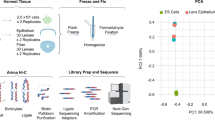Abstract
RING finger protein 2 (RNF2) contains a conserved Nterminal RING finger domain and functions as an E3 ligase. As a member of the Polycomb group family of proteins, RNF2 also represses a number of genes involved in development, differentiation, malignant transformation and cell cycle. Herein, using chromatin immunoprecipitation cloning, 33 RNF2-responding loci were identified in the genome of HEK293 human kidney cells. Luciferase reporter assays showed that among them, 26 and 2 loci acted as a repressor and an activator, respectively. RNA interference revealed that the identified RNF2-responding sequences regulated the transcriptional activity of nearby promoters. This study may contribute to elucidating the mechanism underlying RNF2-mediated transcriptional regulation.
Similar content being viewed by others
References
Bantignies, F., and Cavalli, G. (2006). Cellular memory and dynamic regulation of polycomb group proteins. Curr. Opin. Cell Biol. 18, 275–283.
Bloyer, S., Cavalli, G., Brock, H.W., and Dura, J.M. (2003). Identification and characterization of polyhomeotic PREs and TREs. Dev. Biol. 261, 426–442.
Boyer, L.A., Plath, K., Zeitlinger, J., Brambrink, T., Medeiros, L.A., Lee, T.I., Levine, S.S., Wernig, M., Tajonar, A., Ray, M.K., et al. (2006). Polycomb complexes repress developmental regulators in murine embryonic stem cells. Nature 441, 349–353.
Brown, J.L., Mucci, D., Whiteley, M., Dirksen, M.L., and Kassis, J.A. (1998). The Drosophila Polycomb group gene pleiohomeotic encodes a DNA binding protein with homology to the transcription factor YY1. Mol. Cell 1, 1057–1064.
Choi, I., Cho, B.R., Kim, D., Miyagawa, S., Kubo, T., Kim, J.Y., Park, C.G., Hwang, W.S., Lee, J.S., and Ahn, C. (2005). Choice of the adequate detection time for the accurate evaluation of the efficiency of siRNA-induced gene silencing. J. Biotechnol. 120, 251–261.
Choi, D., Lee, S.J., Hong, S., Kim, I.H., and Kang, S. (2008). Prohibitin interacts with RNF2 and regulates E2F1 function via dual pathways. Oncogene 27, 1716–1725.
de Napoles, M., Mermoud, J.E., Wakao, R., Tang, Y.A., Endoh, M., Appanah, R., Nesterova, T.B., Silva, J., Otte, A.P., Vidal, M., et al. (2004). Polycomb group proteins Ring1A/B link ubiquitylation of histone H2A to heritable gene silencing and X inactivation. Dev. Cell 7, 663–676.
Janke, C., Martin, D., Giraud-Panis, M.J., Decoville, M., and Locker, D. (2003). Drosophila DSP1 and rat HMGB1 have equivalent DNA binding properties and share a similar secondary fold. J. Biochem. 133, 533–539.
Lee, S.J., Choi, J.Y., Sung, Y.M., Park, H., Rhim, H., and Kang, S. (2001). E3 ligase activity of RING finger proteins that interact with Hip-2, a human ubiquitin-conjugating enzyme. FEBS Lett. 503, 61–64.
Lee, S.J., Choi, D., Rhim, H., and Kang, S. (2005). E3 ubiquitin ligase RNF2 interacts with the S6′ proteasomal ATPase subunit and increases the ATP hydrolysis activity of S6′. Biochem. J. 389, 457–463
Lee, S.J., Choi, D., Rhim, H., Choo, H.J., Ko, Y.G., Kim, C.G., and Kang, S. (2008). PHB2 interacts with RNF2 and represses CP2c-stimulated transcription. Mol. Cell. Biochem. 319, 69–77.
Pan, X., Song, Z., Zhai, L., Li, X., and Zeng, X. (2005). Chromatinremodeling factor INI1/hSNF5/BAF47 is involved in activation of the colony stimulating factor 1 promoter. Mol. Cells 20, 183–188.
Ringrose, L., and Paro, R. (2004). Epigenetic regulation of cellular memory by the Polycomb and Trithorax group proteins. Annu. Rev. Genet. 38, 413–443.
Roh, T.Y., Wei, G., Farrell, C.M., and Zhao, K. (2007). Genomewide prediction of conserved and nonconserved enhancers by histone acetylation patterns. Genome Res. 17, 74–81.
Sanchez-Beato, M., Sanchez, E., Gonzalez-Carrero, J., Morente, M., Diez, A., Sanchez-Verde, L., Martin, M.C., Cigudosa, J.C., Vidal, M., and Piris, M.A. (2006). Variability in the expression of polycomb proteins in different normal and tumoral tissues. A pilot study using tissue microarrays. Mod. Pathol. 19, 684–694.
Schwartz, Y.B., and Pirrotta, V. (2008). Polycomb complexes and epigenetic states. Curr. Opin. Cell Biol. 20, 266–273.
Shunmei, E., Zhao, Y., Huang, Y., Lai, K., Chen, C., Zeng, J., and Zou, J. (2010). Heat shock factor 1 is a transcription factor of Fas gene. Mol. Cells 29, 527–531.
Sing, A., Pannell, D., Karaiskakis, A., Sturgeon, K., Djabali, M., Ellis, J., Lipshitz, H.D., and Cordes, S.P. (2009). A vertebrate Polycomb response element governs segmentation of the posterior hindbrain. Cell 138, 885–897.
Sparmann, A., and van Lohuizen, M. (2006). Polycomb silencers control cell fate, development and cancer. Nat. Rev. Cancer 6, 846–856.
Squazzo, S.L., O’Geen, H., Komashko, V.M., Krig, S.R., Jin, V.X., Jang, S.W., Margueron, R., Reinberg, D., Green, R., and Farnham, P.J. (2006). Suz12 binds to silenced regions of the genome in a cell-type-specific manner. Genome Res. 16, 890–900.
van der Stoop, P., Boutsma, E.A., Hulsman, D., Noback, S., Heimerikx, M., Kerkhoven, R.M., Voncken, J.W., Wessels, L.F., and van Lohuizen, M. (2008). Ubiquitin E3 ligase Ring1b/Rnf2 of polycomb repressive complex 1 contributes to stable maintenance of mouse embryonic stem cells. PLoS ONE 3, e2235.
Vidal, M. (2009). Role of polycomb proteins Ring1A and Ring1B in the epigenetic regulation of gene expression. Int. J. Dev. Biol. 53, 355–370.
Wang, H., Wang, L., Erdjument-Bromage, H., Vidal, M., Tempst, P., Jones, R.S., and Zhang, Y. (2004). Role of histone H2A ubiquitination in Polycomb silencing. Nature 431, 873–878.
Weinmann, A.S., Bartley, S.M., Zhang, T., Zhang, M.Q., and Farnham, P.J. (2001). Use of chromatin immunoprecipitation to clone novel E2F target promoters. Mol. Cell. Biol. 21, 6820–6832.
Author information
Authors and Affiliations
Corresponding author
About this article
Cite this article
Choi, D., Kang, S. Identification and characterization of RNF2 response elements in human kidney cells. Mol Cells 31, 247–253 (2011). https://doi.org/10.1007/s10059-011-0033-7
Received:
Revised:
Accepted:
Published:
Issue Date:
DOI: https://doi.org/10.1007/s10059-011-0033-7




